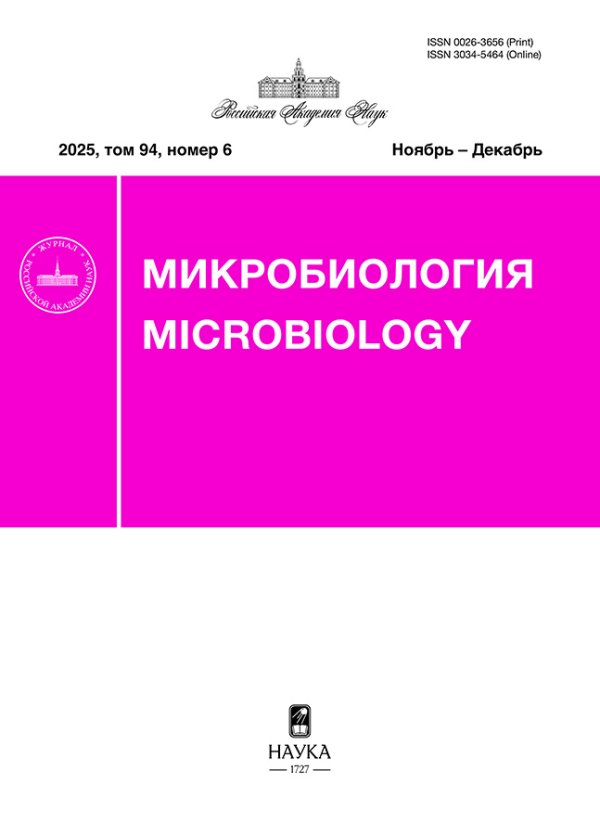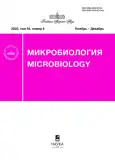Microbiology
ISSN (print):0026-3656
Media registration certificate: No. 0110237 dated 02/09/1993
Founders
- Russian Academy of Sciences
- Institute of Microbiology of the Russian Academy of Sciences
Editor-in-Chief
- Nikolay Viktorovich Pimenov, Doctor of Biological Sciences
Frequency / Access
6 issues per year / Subscription
Included in
White List (2nd level), Higher Attestation Commission List, RISC
Edição corrente
Volume 94, Nº 6 (2025)
EXPERIMENTAL ARTICLES
The Structure of the Anoxygenic Phototrophic Bacterial Community and Features of Green Sulfur Bacteria in the Meromictic Lake Bol’shiye Khruslomeny (Oleniy Island, Kandalaksha Bay of the White Sea, Murmansk Region, Russia)
Resumo
 497–510
497–510


Phototrophic Communities of Algo-Bacterial Mats of the Unique Relict Salt Pool Manych-Gudilo
Resumo
 511–526
511–526


Methanoculleus bovis sp. nov., a New Methane-Producing Hydrogen-Utilizing Archaea from the Rumen of a Cow
Resumo
A new methanogen, strain 7TT, was isolated from the rumen of a cow (Moscow region, Russia). Morphologically, the strain is composed of non-motile coccoid cells of irregular shape, 1.3–4.3 μm in size, and small aggregates thereof. The strain uses exclusively a mixture of hydrogen and carbon dioxide as energy substrates for methanogenesis and requires the presence of acetate in the culture medium. The cells grow at a temperature of 20–53°C (optimum 45°C), pH 6.5–7.8 (optimum pH 7.2–7.4), and are tolerant to NaCl levels up to 0.34 M. According to the 16S rRNA gene sequence analysis, the new methanogen belongs to the genus Methanoculleus, sharing a gene similarity level of 98.16% with the closest species of this genus, M. bourgensis MS2T. The average nucleotide similarity (ANI) between the genomes of strains 7TT and M. bourgensis MS2T was 88.24%, and the virtual estimate of hybridization of the genomes of these two strains was 31.40%. The G + C content of genomic DNA is 61.27% mol. %. Based on the phylogenetic analysis and physiological and biochemical properties of the isolate, we propose to classify the isolated strain 7TT (= VKM B-3409T = JCM 39547T) as a new species Methanoculleus bovis sp. nov.
 527–539
527–539


Hydrocarbon-Oxidizing Actinomycetes from Lake Sapropel
Resumo
A high number of culturable bacteria of the genus Streptomyces (7.84 ± 0.9) × 107 CFU/g was revealed in the actinomycete community of lake sapropel of OOO TPK Kamskiy Sapropel (Naberezhnye Chelny, Republic of Tatarstan, Russian Federation). A total of 14 strains of streptomycetes were isolated in pure culture, growing in a wide range of temperatures and sodium chloride content, possessing hydrolytic, antibiotic and urease activity, capable of biofilm growth, changing the rheological characteristics of the culture fluid when growing on crude oil (Δσ interfacial tension up to 23 mN/m). The ability of streptomycetes to degrade oil n-alkanes with a chain length of C11−C30 was revealed; the addition of starch to the medium activated this process. This makes streptomycetes promising agents both for use in biotechnologies for enhancing oil recovery and in the creation of biopreparations for cleaning soils from oil and oil products.
 540–548
540–548


Features of Betaine Reduction by Haloalkaliphilic Bacteria Alkaliphilus peptidifermentans during Growth on Amino Acids and Ethanolamine
Resumo
 549–564
549–564


Serine Variant of the Reductive Glycine Pathway of CO2 Fixation in the Anaerobic Thermophile Parvivirga hydrogeniphila
Resumo
 565–572
565–572


Pleiotropic Effects of Knockout Mutations in the TPS1 and TPS2 Genes Encoding Trehalose Biosynthesis Enzymes of Saccharomyces cerevisiae
Resumo
 573–581
573–581


The Role of Osmolytes and Membrane Lipids in Cold Adaptation in the Psychrophilic Ascomycete Leuconeurospora pulcherrima
Resumo
 582–593
582–593


Molecular Analysis of Phylogenetic Diversity of Halophilic Methylotrophic Bacterial Communities
Resumo
 594–604
594–604


Analysis of Biofilms Formed by Bacteria of the Genus Azospirillum in Soil
Resumo
 605–623
605–623


Digestive Enzyme Activity and Gut Microbiota Community in African Catfish Clarias gariepinus
Resumo
To improve the growth efficiency and biomass accumulation rate of fish grown in aquaculture, it is necessary to have information on the activity of digestive enzymes and the composition of the intestinal microbiota involved in the digestion of the main components of the feed. In our work, we studied for the first time the activity of glycosidases and proteinases in the intestinal mucosa and chyme, as well as the composition of the intestinal microbiome of two size groups of African catfish Clarias gariepinus grown in tanks with a closed water supply system. Total amylolytic and total proteolytic activities were significantly higher in small fish compared to large ones, the activity of disaccharidases (sucrase and maltase) in the intestinal mucosa did not depend on the fish size. In both size-age groups of African catfish, five bacterial phyla dominated: Pseudomonadota, Bacillota, Actinomycetota, Fusobacteriota and Bacteroidota. In the group of small fish, Pseudomonadota accounted for almost half of the number of intestinal bacteria; in large catfish, the distribution of these bacterial phyla was more uniform. For the first time, a relationship was found between the activity of digestive enzymes and the relative abundance of bacteria of different taxa. The highest positive correlation in the chyme of small catfish was found for the total proteolytic activity with bacteria of the order Lactobacillales of the class Bacilli; in large catfish, with bacteria of the orders Actinomycetales and Bacillales, and the total amylolytic activity with bacteria of the order Fusobacteriales and Clostridiales (Eubacteriales). The data obtained can be used to adjust the composition of the microbiome and digestive enzymes in order to obtain greater biomass of catfish in aquaculture.
 624–636
624–636


Physiological, Biochemical and Toxigenic Properties of Stachybotrys chartarum Growing on Technogenic Substrates
Resumo
 637–652
637–652


Functional Chitosan Films with Improved Physico-Mechanical and Antibacterial Properties Against Bacillus subtilis and Escherichia coli
Resumo
 653–663
653–663


Antifungal Activity of Shell Nanoparticles of Chitosan Asparaginate
Resumo
 664–675
664–675


CHRONICLES
DEDICATED TO THE 90TH ANNIVERSARY OF THE ESTABLISHMENT OF THE S.N. VINOGRADSKY INSTITUTE OF MICROBIOLOGY AND THE 10TH ANNIVERSARY OF THE FEDERAL RESEARCH CENTER “FUNDAMENTALS OF BIOTECHNOLOGY” OF THE RUSSIAN ACADEMY OF SCIENCES
 676–678
676–678












